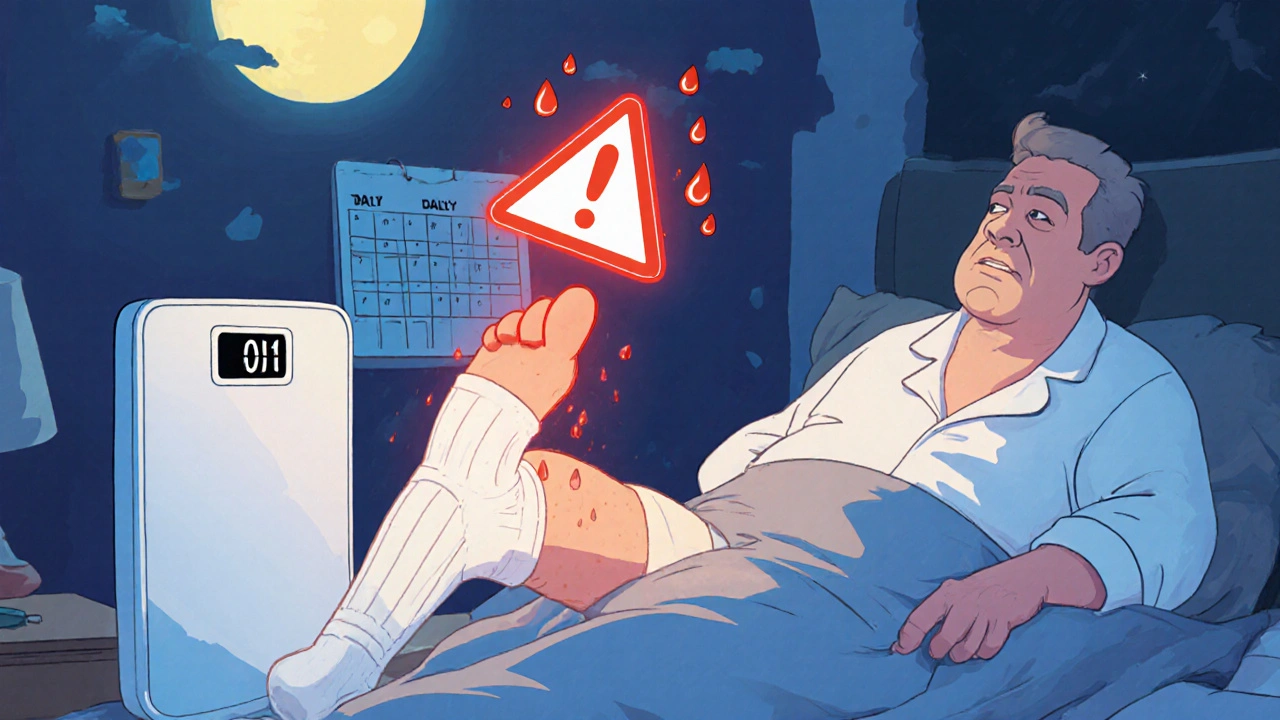Swelling in your ankles, feet, or hands after starting a new medication isn’t always harmless. It’s common - but it’s also a red flag that could mean something serious is happening inside your body. If you’ve noticed your socks leaving marks, your shoes feel tighter, or your legs look puffy by the end of the day, you’re not imagining it. About 4.4 million Americans experience swelling caused by medications each year, and many don’t realize it’s linked to what they’re taking. The good news? Most cases are manageable. The bad news? Some can sneak up on you until it’s too late.
Which Medications Cause Swelling?
Not all drugs cause swelling the same way. Some make your body hold onto water. Others open up tiny blood vessels so fluid leaks out. Here are the most common culprits:
- Calcium channel blockers like amlodipine (Norvasc) - used for high blood pressure - cause swelling in 10-20% of users. At 10mg daily, about 25% of people get noticeable ankle swelling. Switching to another blood pressure med like losartan often fixes it.
- Gabapentin and pregabalin (Neurontin, Lyrica), used for nerve pain and seizures, trigger swelling in 6-8% of patients. One Reddit user reported his ankles swelled so badly he couldn’t wear shoes - until he switched meds.
- Thiazolidinediones like pioglitazone (Actos) and rosiglitazone (Avandia), prescribed for type 2 diabetes, cause fluid retention in up to 10% of users. These drugs are especially risky for people with heart problems.
- NSAIDs like ibuprofen and naproxen cause mild swelling in about 3% of regular users. It’s often overlooked because people think it’s just from standing too long.
- Corticosteroids like prednisone - even short courses - can make you retain fluid. If you’re taking more than 20mg daily for over two weeks, swelling is likely.
- Hormonal meds - birth control pills with ethinyl estradiol and hormone replacement therapy - cause mild swelling in 5-15% of users, especially in women over 50.
These aren’t rare side effects. They’re predictable. And they’re often dismissed too easily.
When Is Swelling Just a Side Effect - And When Is It Dangerous?
Not all swelling is created equal. Medication-related edema usually shows up in both ankles, feels soft when you press it (called “pitting”), and gets worse by the end of the day. It often improves overnight or when you elevate your legs.
But if your swelling looks like this, stop ignoring it:
- One leg only - especially if it’s red, warm, or painful. This could be a blood clot (deep vein thrombosis).
- Swelling with shortness of breath - even mild breathlessness when walking up stairs. This could mean fluid is building up in your lungs (pulmonary edema).
- Rapid weight gain - more than 2-3 pounds in 24 hours, or 5% of your body weight in a month. That’s not just water weight. It’s your body holding onto fluid because your heart or kidneys are struggling.
- Swelling with fatigue, nausea, or confusion - signs your organs are under stress.
- Swelling that doesn’t go down overnight - true medication swelling usually improves with rest. If it’s still there in the morning, something else might be going on.
Dr. Mark A. Danchenko, a cardiologist at Johns Hopkins, says: “Any new bilateral swelling in someone on amlodipine should make you check their heart function - especially if they’re also tired or out of breath.”
Many doctors blame the medication and move on. But in older adults, swelling is often a sign of heart failure, kidney disease, or liver problems - not just a side effect. The American Geriatrics Society lists amlodipine, gabapentin, and pioglitazone as potentially inappropriate for people over 75 because of how often they cause dangerous fluid buildup.
What You Can Do Right Now
If you’re experiencing swelling and you’re on one of these meds, here’s what to do:
- Track your weight daily. Use the same scale, at the same time of day (morning, after bathroom, before eating). A 2.2-pound (1kg) jump in 24 hours means your body is retaining fluid.
- Elevate your legs. Put them above heart level for 15-20 minutes, four times a day. Clinical studies show this reduces ankle swelling by 1.5cm in just two days.
- Wear compression socks. 20-30 mmHg pressure socks can cut swelling by 30% in a week. They’re not glamorous, but they work.
- Reduce sodium. Cut salt to under 2,000mg a day. Most people eat 3,400mg. A 2023 study showed that lowering sodium reduced swelling in 72 hours.
- Don’t wait for your next appointment. If swelling is new, worsening, or paired with breathing trouble, call your doctor now. Don’t wait weeks.
One patient on Reddit shared: “Compression socks + leg elevation reduced my amlodipine swelling by 80% without changing meds.” That’s a win - but it’s not a fix. It’s damage control.

When You Need to See a Doctor Immediately
Some situations can’t be managed at home. Go to urgent care or the ER if you have:
- Sudden swelling in one leg with redness or warmth
- Difficulty breathing, especially when lying down
- Chest pain or rapid heartbeat
- Swelling with confusion, dizziness, or decreased urination
- Swelling that came on overnight with no clear trigger
These aren’t “wait and see” symptoms. They’re warning signs of heart failure, kidney failure, or a life-threatening blood clot. The FDA has received over 12,000 reports of edema linked to prescription drugs since early 2022 - and many of those cases were preventable.
What Your Doctor Should Be Checking
If you mention swelling, your doctor should do more than say, “It’s the meds.” Here’s what a proper evaluation includes:
- Weight trend - has it gone up fast?
- Blood pressure - high or low?
- Heart exam - listening for crackles in lungs or extra heart sounds
- Leg measurements - comparing circumference around ankles
- Blood tests - kidney function (creatinine), liver enzymes, protein levels
- Urine test - for protein (high levels suggest kidney disease)
- NT-proBNP or BNP blood test - if heart failure is suspected
The American College of Physicians says all patients on corticosteroids above 20mg prednisone for more than two weeks should have monthly checks for swelling, weight gain, and blood pressure. That’s not optional. It’s standard.
And yet, many primary care doctors skip these steps. One 2023 survey found only 65% follow these guidelines. Specialists do better - 85% - but you can’t rely on that. Be your own advocate.
What Happens If You Ignore It?
Ignoring swelling isn’t just inconvenient - it can be deadly. A patient on HealthUnlocked wrote: “My doctor dismissed my pioglitazone swelling as ‘just a side effect’ until I developed pulmonary edema and ended up in the hospital.”
Fluid overload from meds can:
- Worsen heart failure
- Trigger kidney damage
- Lead to hospitalization
- Require emergency diuretics
- Force you to stop a medication you need for another condition
For people with diabetes, stopping pioglitazone means losing a drug that helps control blood sugar. But keeping it could cost you your heart. That’s why doctors need to weigh the risks - and you need to speak up.

What’s New in Managing Medication Swelling
There’s progress. In March 2023, the FDA approved the first wearable device - VascuComp Plus - that uses bioimpedance to detect fluid buildup before you even see swelling. It’s not in every clinic yet, but it’s coming.
Some hospitals now use electronic alerts in patient records. Mayo Clinic reported a 22% drop in severe edema cases after adding alerts for high-risk drug combinations.
And research is underway for new versions of amlodipine with less swelling risk. Results are expected in early 2024.
But for now, the tools are simple: know your meds, track your body, and don’t wait for permission to ask questions.
Frequently Asked Questions
Can swelling from medication go away on its own?
Sometimes, yes - especially if it’s mild and you’re on a low dose. Swelling from amlodipine or gabapentin often improves after a few weeks as your body adjusts. But if it’s getting worse, spreading, or paired with other symptoms, it won’t fix itself. Don’t assume it’s temporary. Monitor it closely.
Is swelling in only one leg always a blood clot?
Not always, but it’s a major red flag. Swelling in one leg - especially if it’s red, warm, painful, or accompanied by shortness of breath - could mean a deep vein thrombosis (DVT). About 95% of DVT cases show unilateral swelling. Don’t wait. Get it checked within hours.
Can I take diuretics (water pills) to reduce swelling from meds?
Not without medical supervision. Diuretics can help, but they can also cause electrolyte imbalances, low blood pressure, or kidney issues - especially if you’re already on multiple meds. They’re not a quick fix for drug-induced swelling. The real solution is adjusting the cause, not just masking the symptom.
Does drinking more water help with swelling?
No - and it might make it worse. Swelling from meds isn’t caused by dehydration. It’s caused by fluid leaking out of blood vessels or your body holding onto sodium. Drinking more water doesn’t flush it out. Reducing salt and elevating your legs does.
Should I stop my medication if I get swollen ankles?
Never stop a prescribed medication on your own. But do contact your doctor right away. They may switch you to a different drug (like losartan instead of amlodipine) or lower the dose. Stopping suddenly can be dangerous - especially for blood pressure or seizure meds.
Is swelling from medication more common in older adults?
Yes - and it’s more dangerous. People over 75 are 40% more likely to develop serious swelling from meds like amlodipine, gabapentin, and pioglitazone than those under 65. Their kidneys and hearts don’t handle fluid shifts as well. That’s why the American Geriatrics Society advises avoiding these drugs in older adults unless absolutely necessary.
What to Do Next
If you’re on a medication that causes swelling, start tracking today. Weigh yourself daily. Note when the swelling gets worse. Take photos of your ankles. Write down any new symptoms - even small ones.
Make a list of all your meds and bring it to your next appointment. Ask: “Could any of these be causing my swelling?” Don’t wait for them to ask. If your doctor brushes you off, ask for a referral to a cardiologist or nephrologist. You know your body best.
Swelling isn’t always a minor side effect. Sometimes, it’s your body screaming for help. Listen.





One comment
Been on amlodipine for 3 years. Socks leave marks every night. Started lifting legs on the couch after dinner and using compression socks. No more puffiness by morning. Simple stuff works if you just do it.
Thank you for writing this with such clarity. I’ve been terrified to bring up my swelling with my doctor because they always say 'it’s just the meds.' But now I know exactly what questions to ask - weight tracking, leg elevation, sodium intake. I’m printing this out and taking it to my next appointment. You’ve given me back some power.